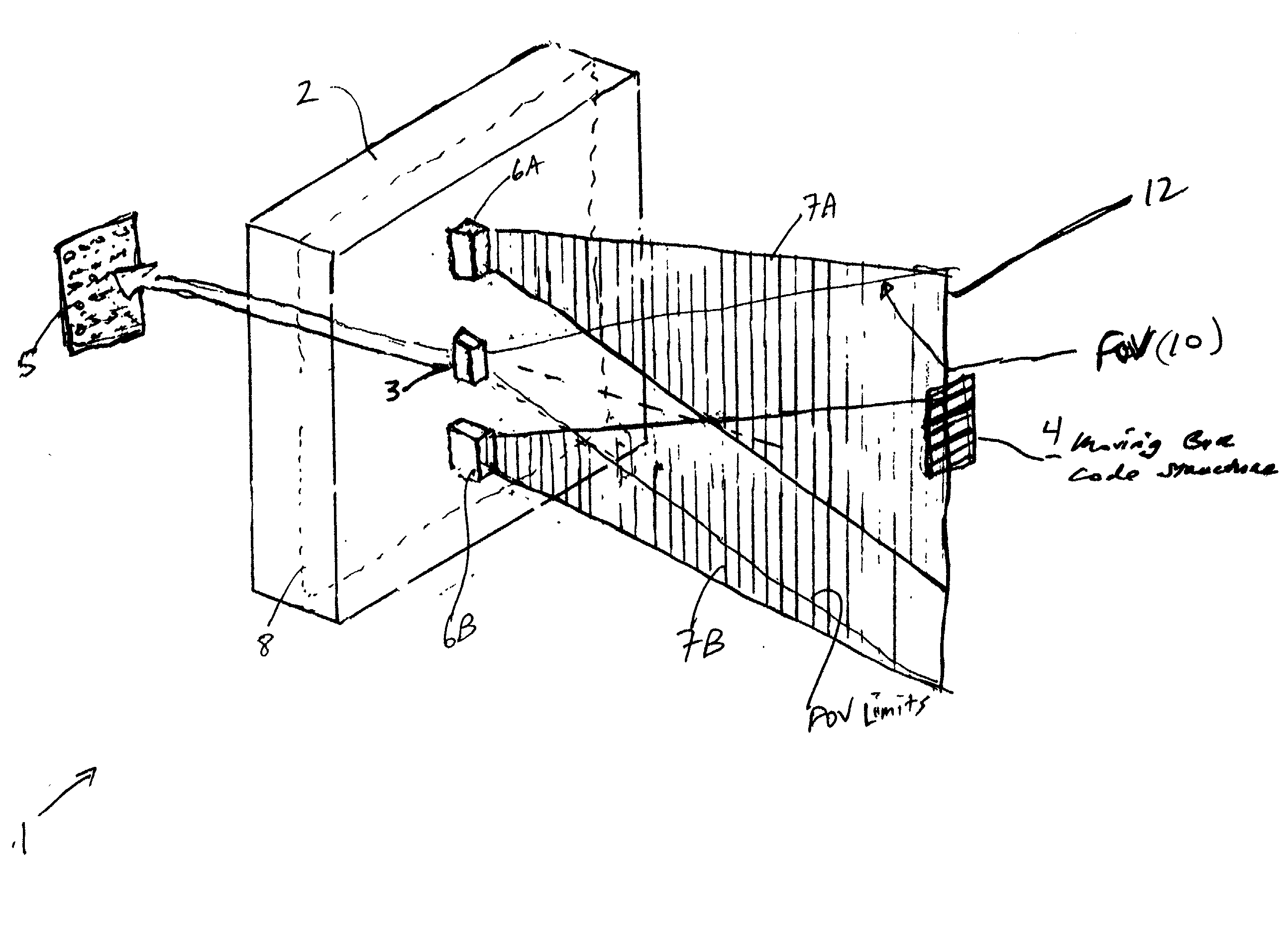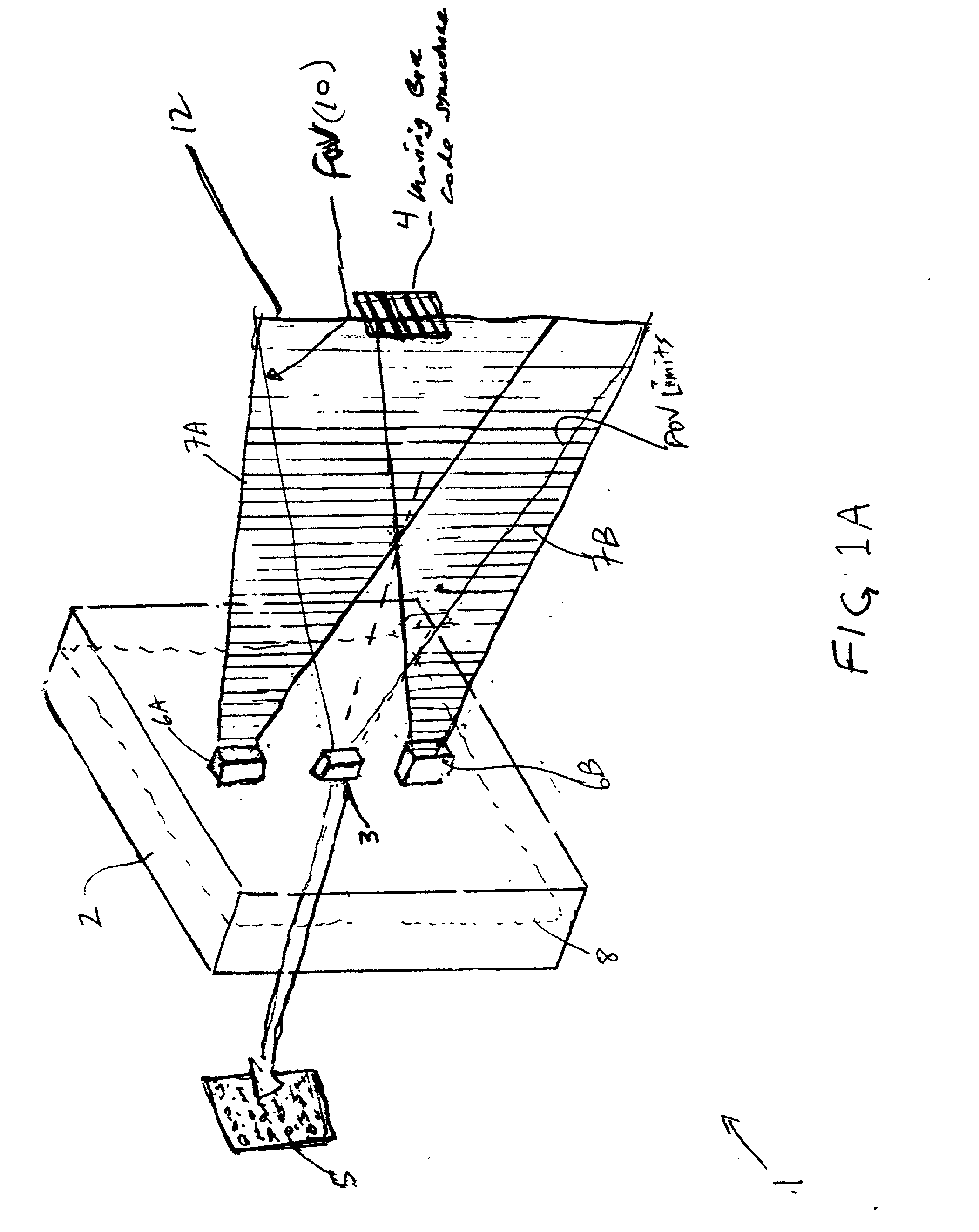Method of and system for producing images of objects using planar laser illumination beams and image detection arrays
a technology of image detection array and laser illumination beam, which is applied in the direction of electromagnetic radiation sensing, exposure control, instruments, etc., can solve the problems of wasting heat, large, heavy and expensive, and reducing the efficiency of scanning devices, so as to avoid shortcomings and drawbacks.
- Summary
- Abstract
- Description
- Claims
- Application Information
AI Technical Summary
Benefits of technology
Problems solved by technology
Method used
Image
Examples
embodiment 1
[0365] In accordance with the present invention, the planar laser illumination arrays 6A and 6B, the linear image formation and detection module 3, the folding / sweeping FOV mirror 9', and the planar laser illumination beam folding / sweeping mirrors 37A' and 37B' employed in this generalized system embodiment, are fixedly mounted on an optical bench or chassis 8 so as to prevent any relative motion (which might be caused by vibration or temperature changes) between: (i) the image forming optics (e.g. imaging lens) within the image formation and detection module 3 and the FOV folding / sweeping mirror 9' employed therewith; and (ii) each planar laser illumination module (i.e. VLD / cylindrical lens assembly) and the planar laser illumination beam folding / sweeping mirrors 37A' and 37B' employed in this PLIIM system configuration. Preferably, the chassis assembly should provide for easy and secure alignment of all optical components employed in the planar laser illumination arrays 6A' and 6B...
embodiment 40
[0370] In accordance with the present invention, the planar laser illumination arrays 6A and 6B, the linear image formation and detection module 3', and any non-moving FOV and / or planar laser illumination beam folding mirrors employed in any configuration of this generalized system embodiment, are fixedly mounted on an optical bench or chassis so as to prevent any relative motion (which might be caused by vibration or temperature changes) between: (i) the image forming optics (e.g. imaging lens) within the image formation and detection module 3' and any stationary FOV folding mirrors employed therewith; and (ii) each planar laser illumination module (i.e. VLD / cylindrical lens assembly) and any planar laser illumination beam folding mirrors employed in the PLIIM system configuration. Preferably, the chassis assembly should provide for easy and secure alignment of all optical components employed in the planar laser illumination arrays 6A and 6B as well as the image formation and detec...
embodiment 120
[0510] Referring now to FIGS. 9 and 10, a unitary package identification and dimensioning system of the first illustrated embodiment 120 will now be described in detail.
[0511] As shown in FIG. 10, the unitary system 120 of the present invention comprises an integration of subsystems, contained within a single housing of compact construction supported above the conveyor belt of a high-speed conveyor subsystem 121, by way of a support frame or like structure. In the illustrative embodiment, the conveyor subsystem 121 has a conveyor belt width of at least 48 inches to support one or more package transport lanes along the conveyor belt. As shown in FIG. 10, the unitary system comprises four primary subsystem components, namely: (1) a LADAR-based package imaging, detecting and dimensioning subsystem 122 capable of collecting range data from objects on the conveyor belt using a pair of multi-wavelength (i.e. containing visible and IR spectral components) laser scanning beams projected at ...
PUM
 Login to View More
Login to View More Abstract
Description
Claims
Application Information
 Login to View More
Login to View More - R&D
- Intellectual Property
- Life Sciences
- Materials
- Tech Scout
- Unparalleled Data Quality
- Higher Quality Content
- 60% Fewer Hallucinations
Browse by: Latest US Patents, China's latest patents, Technical Efficacy Thesaurus, Application Domain, Technology Topic, Popular Technical Reports.
© 2025 PatSnap. All rights reserved.Legal|Privacy policy|Modern Slavery Act Transparency Statement|Sitemap|About US| Contact US: help@patsnap.com



